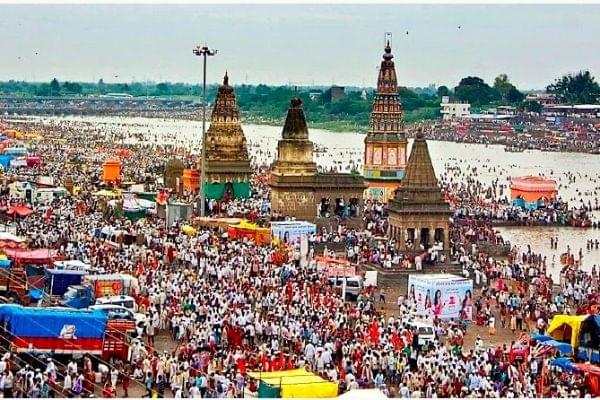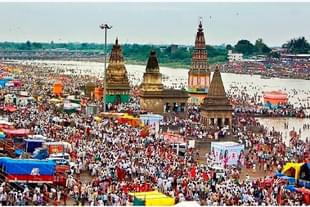Culture
The Pandharpur Wari: The Journey Of The Devout
Adithi Gurkar
Aug 04, 2021, 07:36 PM | Updated 08:18 PM IST
Save & read from anywhere!
Bookmark stories for easy access on any device or the Swarajya app.


Every year, in the Ashadh month of the Hindu calendar, lakhs of devotees across Maharashtra take a pilgrimage on foot to the Vithoba temple in Pandharpur. The procession is called the Wari and the devotees-the Warkaris ( literally 'those who do the wari'). This 800-year-old tradition is a distinctive part of the Maharashtrian culture and is the ritualistic essence of the Wakari Panth (a sampradaya within the Bhakti tradition).
Four processions take place in the months of Chaitra (March-April), Ashadh (June-July), Kartik (October-November) and Magh (January-February). Of these, the Ashadhi Ekadashi Wari is the most popular.
The onset of the monsoon is a convenient time for the Warkaris. As most belong to agrarian communities, they commence the 21-day journey after sowing seeds for the season, a time when their fields require not much work or attention.
Men in Gandhi caps, women with tulsi pots on their heads, saffron flags, musical instruments, bhajans, kirtans and tastefully decorated vehicles that play melodious devotional music are characteristic of the Wari today; however, this was not always the case. The procession has evolved over the years, as have the associated legends and its unique systems of organization and management.
The Origins
The Wari tradition can be traced to Vitthala Pant, who was the father of Sant Dyaneshwar, the founder of the sect and the author of -Dyaneshwari, a Marathi commentary on the Bhagavad Gita (a core text of the panth). In one of his thirteenth-century Ovis (poetic metre), Sant Dyaneshwar thanks his father for taking him to the pandhari yatra to receive the darshan of Lord Vithalla, a form of Krishna and the presiding deity of Pandharpur. The tradition was also followed by Sant Namdev, a revered contemporary of Sant Dyaneshwar, who like Dyaneshwar Maharaja, had accorded Lord Vittala the status of mother. Sant Namdev is credited with the following composition:
"Here come the children of Hari (God), the brave Warikaras of Pandharpur, whose being is full of devotion and love. Coloured by Hari, they dance without reserve… At the Pandhari maher, there is Mother Vitthal. O Hari! Do not send us to Vaikuntha. Let us reside in Pandhari all the time."- Sant Namdev
The Evolution
Sant Bhanudas and Sant Eknath continued the pilgrimage into the fifteenth and sixteenth centuries. In the seventeenth century, Sant Tukaram began to perform the annual pilgrimage by wearing the padukas (sandals) of Sant Dyaneshwar around his neck. After his death, Sant Tukaram's youngest son Narayan Maharaja inherited the tradition. The present system of carrying the padukhas on palkis (palanquins) was first introduced by Haibatravbaba Arphalkar, a courtier of the Scindias - the Maharata rulers of Gwalior in the nineteenth century.
Haibatravbaba Arphalkar became a great devotee of Dyaneshwar Maharaja after his prayers to the Sant lead to his release from the captivity of dacoits. He introduced a separate palki for Sant Dyaneshwar after it had merged with the palki of Sant Tukaram. Under his supervision, the Wari began to resemble a military procession with additions being- elephants, horses and groupings of thousands of devotees called the Dindis.
Dindis
Amongst the numerous palkis of Sant - Kavis ( poet- saints) brought to Pandharpur today, the palkis of Sant Dyaneshawr and Sant Tukaram happen to be the oldest and most revered. The palkis start their journeys from the samadhis (commemorative shrines) of these saints.
Sant Dyaneshawr's palki beings the Wari in the town of Alandi and reaches Pandharpur via the cities of Pune, Saswad, Jejuri, Lonand, Taradgaon, Phaltan, Natepute, Malshiras, Velapur, Shegaon and Wakhri. At the same time, Sant Tukaram's palki would have begun its journey from the town of Dehu and traversed the cities of Akurdi, Loni Kalbhor, Yavat, Varvand, Baramati, Indapur and Aklu before reaching Pandharpur. The journey, which begins on the eighth or ninth day of the Hindu month of Jyestha, ends at the abode of lord Vittala on the eleventh day of Aashaad.
Sant Dyaneshwar's palki is accompanied by about 250 dindis, while Sant Tukaram's palanquin is accompanied by over 330 dindis. Each Dindi is assigned a number denoting its position in the Wari and follows a predetermined itinerary.
Singing, chanting and dancing are the essence of Dindis. Instruments such as the veena and mridangam add to the musical fervour. Entertainment is provided at various pit stops through fairs and ceremonies such as the 'ringan', which is a race between two horses, one with a rider and one without. The horse that wins the race is said to have been ridden by the Sant himself.
An interesting feature of the procession is the Seva Dindis. Along the Wari, the Dindis perform various types of seva (selfless service) such as the Amrut Kalash ( annadana, or donation of food), Narayan seva (medical help) and the building and repairing rural infrastructure.
The event is also used as an opportunity for social messaging. For example, in 2016, the Maharashtra government, as part of the Swach Bharat Abhiyan, launched the 'Nirmal Wari' initiative to promote cleanliness in the cities that are part of the Wari. In 2019, the Maharashtra State Women's Commission conducted the 'Wari Nari Shakti' drive through which women-centric initiatives such as the distribution of sanitary pads and talks on menstrual hygiene were held.
The use of a DRDO designed and manufactured bullock cart to carry Sant Dyaneshwar's palkhi in 2013 is perhaps the greatest testimony to the evolution of the Wari. The carbon composite built chariot was embossed with silver and fitted with sensors and battery power motors which would kick start when the bullocks began to tire.
The Temple
The three-week journey ends at Pandharpur, the abode of Lord Vittala. Legend has it that Pundalik, an earnest devotee of the lord, had once even commanded the violent Bhima river to not disturb his parents' sleep. Impressed with Pundalik's devotion towards his parents, Lord Krishna decided to pay him a visit. When Krishna knocked on Pundalik's door, he was busy in service of his parents; not wanting to leave before his seva was complete, Pundalik threw a brick for Krishna to stand on so as to keep the Lord's feet clean from the wet and muddy monsoon soil. The scene is referenced in one of Sant Tukaram's compositions where he playfully admonishes Pundalik as follows:
'Hey Pundya! Why are you so proud As to make Vitthal stand there? Why are you so bold As to toss a brick to him?…
When Pundalik finally goes to greet Krishna, the god grants him a boon. Pundalik requests for Krishna to stay on earth forever. Krishna agrees and takes the form of Lord Vitoba of Pandharpur, the god who stands on a brick.
Every year Warkaris continue the centuries-old tradition of embarking on a journey to honour their Sants and worship Lord Vitalla. Over the past months owing to COVID -19 restrictions, the Wari has been halted, and only the palkis of the revered Sant-Kavis have been allowed in the temple. However, nothing can dampen the spirit of the devotees; the tradition is sure to be revived with Wakaris dancing their way to Pandharpur in pursuit of the bliss of Lord Panduranaga.





